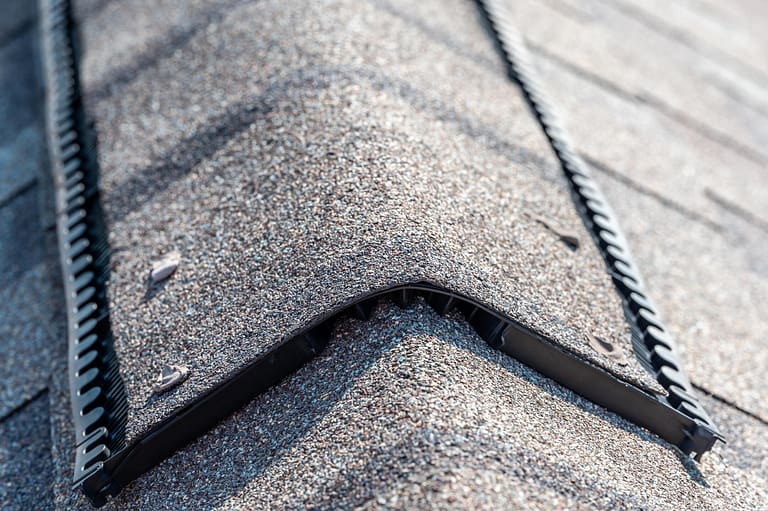
In commercial real estate, staying on top of building maintenance is crucial. One key area that often requires attention is the roof. Commercial roofing systems come in various types, each with its own advantages and disadvantages. Understanding these options can help commercial property owners make informed decisions about which roofing system best suits their needs. In this blog post, we’ll explore the most common types of commercial roofing available in 2024, including:
- Built-Up Roofing (BUR)
- Metal Roofing
- Modified Bitumen Roofing
- Thermoset (EPDM) Roof Membrane
- Thermoplastic (PVC & TPO) Roof Membranes
- Green Roofing
- Shingle Roofing
- Spray Polyurethane Foam (SPF) Roofing
- Single-Ply Membrane Roofing
- Roof Coatings
- Solar Roofing
🏢 11 Common Types of Commercial Roofing
Understanding the common types of commercial roofing is crucial for business owners and property managers, as it helps them make informed decisions about maintenance, durability, and cost-effectiveness. Choosing the right roofing type can significantly impact energy efficiency and the overall lifespan of a building.
1. Built-Up Roofing (BUR)

Built-Up Roofing (BUR) has been a staple in the commercial roofing industry for decades. This type of roofing is composed of multiple layers of bitumen (asphalt) and reinforcing fabrics, making it a durable and long-lasting option.
Benefits of BUR
- Durability: With multiple layers, BUR systems offer excellent resistance to weather, UV rays, and physical damage.
- Low Maintenance: Once installed, BUR systems require minimal maintenance and can last up to 30 years.
- Waterproofing: The multi-layer construction provides superior waterproofing capabilities, protecting your building from leaks and water damage.
Considerations
- Installation Time: BUR installations can be time-consuming and require skilled labor.
- Weight: The multiple layers add significant weight to the structure, which may require additional support.
- Odor: The installation process can produce strong odors from the bitumen.
2. Metal Roofing
Metal roofing systems are known for their longevity and durability. They are typically made from materials like steel, aluminum, and copper, and are often finished with protective coatings to prevent rust and corrosion.
Benefits of Metal Roofing
- Longevity: Metal roofs can last 40-70 years, depending on the material.
- Energy Efficiency: Reflective coatings can reduce cooling costs by reflecting solar heat.
- Low Maintenance: Metal roofs require minimal maintenance and are resistant to cracking and shrinking.
Considerations
- Cost: Initial installation costs can be higher compared to other roofing types.
- Noise: Metal roofs can be noisier during rain or hailstorms, although insulation can mitigate this.
- Expansion and Contraction: Metal expands and contracts with temperature changes, which can affect fasteners over time.
3. Solar Roofing
Solar roofing integrates photovoltaic (PV) panels into the roof, generating electricity while providing the benefits of a traditional roof. This type of roofing is becoming increasingly popular as businesses seek sustainable energy solutions.
Benefits of Solar Roofing
- Energy Savings: Generates electricity, reducing energy costs.
- Environmental Impact: Reduces carbon footprint and reliance on fossil fuels.
- Incentives: Eligible for various tax incentives and rebates.
Considerations
- Cost: Higher initial investment compared to traditional roofing.
- Installation: Requires specialized installation and maintenance.
- Weather Dependency: Energy generation depends on sunlight availability.
4. Thermoset (EPDM) Roof Membrane
Ethylene Propylene Diene Terpolymer (EPDM) is a synthetic rubber roofing membrane widely used in commercial buildings. It is known for its durability and weather resistance.
Benefits of EPDM
- Durability: EPDM roofs can last up to 30 years with proper maintenance.
- Temperature Resistance: These roofs perform well in both hot and cold climates.
- Ease of Repair: EPDM membranes are easy to repair if damaged.
Considerations
- Appearance: Typically black, which can absorb heat unless treated with a reflective coating.
- Installation: Requires skilled labor for proper installation.
- Seams: Seams can be vulnerable to leaks if not sealed correctly.
5. Modified Bitumen Roofing

Modified Bitumen (Mod-Bit) roofing is an asphalt-based system designed for buildings with low-slope or flat roofs. It combines the durability of BUR with modern benefits like flexibility and ease of installation.
Benefits of Modified Bitumen Roofing
- Flexibility: Mod-Bit roofs are flexible, making them resistant to cracking and splitting.
- Ease of Installation: These roofs can be installed quickly, reducing labor costs.
- Waterproofing: The layers provide excellent waterproofing and are often reinforced with fiberglass or polyester.
Considerations
- UV Protection: Mod-Bit roofs require a reflective coating to protect against UV damage.
- Maintenance: Regular inspections are necessary to maintain optimal performance.
- Lifespan: Typically lasts 20-25 years, which is shorter than some other options.
6. Green Roofing
Green roofing systems incorporate vegetation and soil over a waterproof membrane, creating an eco-friendly and aesthetically pleasing roof. They are particularly popular in urban areas.
Benefits of Green Roofing
- Environmental Impact: Reduces urban heat island effect and improves air quality.
- Insulation: Provides natural insulation, reducing energy costs.
- Aesthetic Appeal: Enhances the visual appeal of the building.
Considerations
- Weight: Requires additional structural support.
- Maintenance: Needs ongoing maintenance to keep plants healthy.
- Cost: Higher initial cost due to additional layers and structural requirements.
7. Shingle Roofing
Shingle roofing is not only for residential buildings; it can also be a viable option for commercial properties. Asphalt shingles are common due to their affordability and ease of installation.
Benefits of Shingle Roofing
- Affordability: Cost-effective compared to other roofing options.
- Variety: Available in various colors and styles to match your building.
- Ease of Installation: Quick and easy to install, reducing labor costs.
Considerations
- Durability: Shorter lifespan compared to materials like metal or tile.
- Maintenance: Requires regular inspections and maintenance.
- Weather Resistance: Less resistant to extreme weather conditions.
8. Spray Polyurethane Foam (SPF) Roofing
SPF roofing involves spraying a liquid mixture that expands into a foam, creating a solid layer across the roof. This type of roofing is known for its excellent insulation properties.
Benefits of SPF Roofing
- Insulation: Provides superior insulation, reducing energy costs.
- Seamless: Creates a monolithic layer with no seams, reducing leak potential.
- Lightweight: Adds minimal weight to the building structure.
Considerations
- Installation: Requires professional application.
- UV Protection: Needs a protective coating to shield from UV damage.
- Maintenance: Regular maintenance is essential to prolong lifespan.
9. Single-Ply Membrane Roofing
Single-ply membrane roofing systems are popular for their flexibility and ease of installation. They are available in various materials, including TPO, PVC, and EPDM.
Benefits of Single-Ply Membrane Roofing
- Flexibility: Suitable for various roof shapes and sizes.
- Ease of Installation: Quick and straightforward to install.
- Lightweight: Adds minimal weight to the building structure.
Considerations
- Durability: Lifespan varies depending on the material used.
- Seams: Vulnerable to leaks if not properly sealed.
- Cost: Initial cost can be higher compared to other roofing types.
10. Thermoplastic (PVC & TPO) Roof Membranes

Thermoplastic roofing membranes, including Polyvinyl Chloride (PVC) and Thermoplastic Olefin (TPO), are popular for their durability and energy efficiency. These single-ply membranes are heat-welded at the seams for superior strength.
Benefits of Thermoplastic Roofing
- Energy Efficiency: Reflective surfaces reduce cooling costs.
- Durability: Resistant to chemicals, punctures, and UV radiation.
- Flexibility: Can accommodate building movement without cracking.
Considerations
- Cost: Higher initial cost compared to some other roofing types.
- Installation: Requires specialized equipment and skilled labor.
- Age: Performance can degrade over time if not properly maintained.
11. Roof Coatings
Roof coatings are liquid applications added to existing roofing systems to extend their lifespan and improve performance. They are available in various formulations, including acrylic, silicone, and polyurethane.
Benefits of Roof Coatings
- Cost-Effective: Extends the life of existing roofs without needing a full replacement.
- Energy Efficiency: Reflective coatings reduce cooling costs.
- Weather Resistance: Provides additional protection against UV rays and weather.
Considerations
- Application: Requires professional application for best results.
- Maintenance: Coatings need reapplication over time to maintain effectiveness.
- Compatibility: Not all coatings are compatible with every roofing material.
🙌 Choosing the Right Commercial Roofing Solution for Longevity and Efficiency
Selecting the right commercial roofing system is a critical decision that can impact your building’s longevity, energy efficiency, and overall performance. Each type of commercial roofing has its unique advantages and considerations. By understanding these options, commercial property owners can make informed decisions that align with their specific needs and budget.
At Shingle And Metal Roofs, we pride ourselves on offering top-notch roofing solutions tailored to your unique requirements. Our team of experienced roofing contractors is dedicated to providing high-quality work that lasts. Whether you need a new roof installation, repairs, or maintenance, we are here to help. Ready to find the perfect roofing solution for your commercial property? Contact our team at Shingle And Metal Roofs today and take the first step toward a durable and reliable roofing system.





